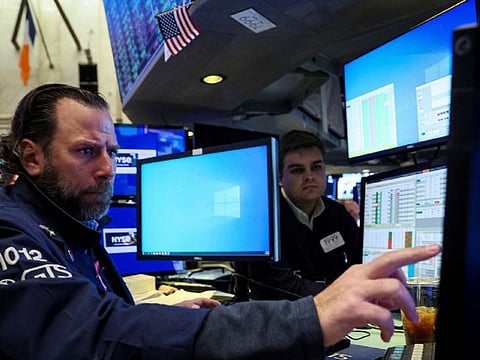Wall Street rally wipes away a year of Fed-induced losses
Macro contribution on equity markets has fallen to 71% from 83% since March

New York: Investors have just turned back the clock on the Fed’s tightening campaign and cast aside the Fed fears that ruled them for 15 months.
The S&P 500 index capped a fifth straight week of gains and is now higher than it was on March 16, 2022, the day the Federal Reserve embarked on the most aggressive rate hikes in four decades. US stocks are not alone “- from the dollar to bond volatility to equity-market positioning, key metrics are back near levels seen before 500 basis points of rate increases.
Markets once bound to the Fed’s efforts to ease economic growth and inflation are now focusing on the health of corporate balance sheets and the potential for a surge in capital outlays as companies retool for an AI boom.
The macro contribution on equity markets has fallen to 71 per cent from 83 per cent since March “- the biggest three-month drop since 2009, according to a Citigroup Inc. model.
“The Fed will probably be a little less important over the next six to 12 months than they have been,” said Jonathan Mackay, head of platform distribution at Schroders. “Other global drivers and fundamental drivers will take more of a bigger role as the Fed potentially starts their pause period.”
“Previously we’ve known that the Fed is just going to hike rates because it has too because inflation is too high,” said Fiona Cincotta, senior market analyst at City Index. “Now, it’s going to be much more data dependent.”
Markets have had a flying first half of 2023, coaxing investors off the sidelines and forcing strategy reversals by some of Wall Street’s loudest bears. A measure for aggregate equity positioning by Deutsche Bank AG turned overweight for the first time in more than 16 months, sending it back to levels last seen before the start of the cycle.
Volatility has tumbled in bonds and equities: the ICE BofA MOVE index of expected price swings in US government debt is trading near its pre-tightening nadir, while the Cboe Volatility index which measures stocks is hovering around levels last seen in 2020.
The dollar’s strength, powered by rates, has also withered with the Bloomberg Dollar Spot Index trading near levels seen in April 2022, down nearly 10 per cent since its record high.
The S&P 500 index posted its mildest reaction on FOMC day in two years. Though it was the first in 11 meetings where policymakers held rates, they also lifted forecasts for higher borrowing costs of 5.6 per cent in 2023, implying two additional quarter-point rate hikes or one half-point increase before the end of the year.
Contrast that with markets that hung on every word Fed officials said in the last year.
The bull market also flies in the face of 65 per cent odds of a US recession within a year, by economists’ reckoning. The collapse of four regional banks and inversions all along the US Treasury curve back the case for an economic downturn. Wall Street veteran Bob Michele anticipates a recession by the end of the year that will force a Fed pivot to easy policy.
For now, the American economy seems to have sustained the assault of rate hikes with resilient labor markets and mostly healthy corporate balance sheets. Among the market’s biggest bears, Bank of America strategists upgraded their target for US stocks and grew more optimistic on the economic outlook, forecasting a “later and more moderate downturn.”
But Peter Chatwell, for one, isn’t convinced the economy or markets can resist the pull of tighter policy for long.
“The rally is typical of a bear market rally, rather than an outright bull market rally,” cautioned the head of global macro strategies trading at Mizuho International Plc. The run-up in prices is “on a weak foundation, vulnerable to a repricing to higher medium term interest rates.”
“Investors appear to have finally thrown the towel and start chasing the rally,” said Emmanuel Cau, head of European equity strategy at Barclays. “So long as US recession keeps being pushed back, we think equities can continue to grind higher.”
Sign up for the Daily Briefing
Get the latest news and updates straight to your inbox



